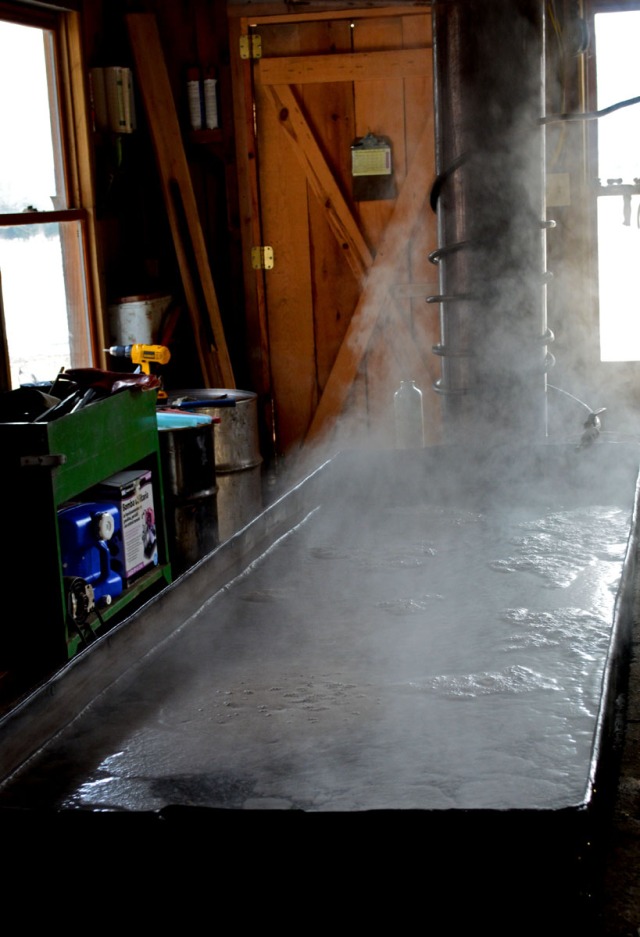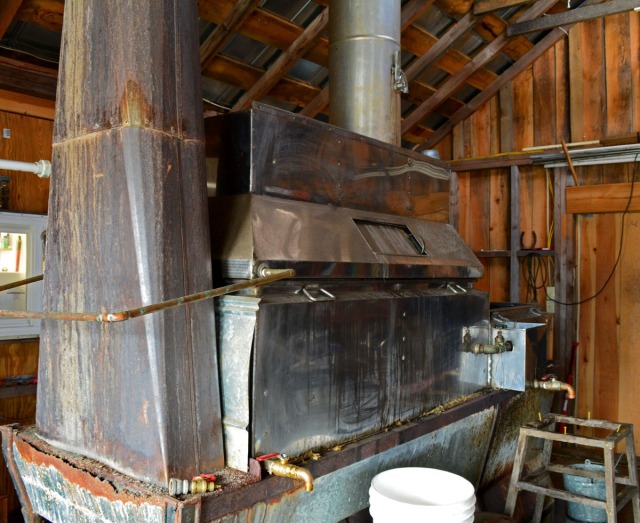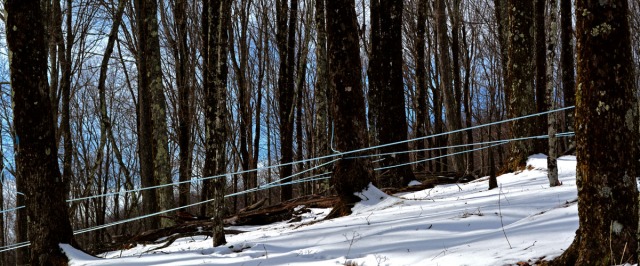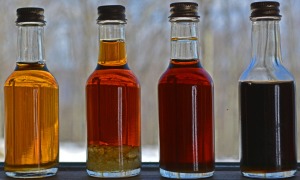Just when you think that winter has frayed your last nerve and spring still seems a distant dream, Mother Nature is quietly working her magic. When the nights are still freezing but the days are starting to warm a bit, the trees begin to draw up moisture from the ground. Nobody really knows when humans first discovered that tree sap was flowing during that particular time of year, then realized that this sap could be collected and boiled down into a delicious syrup. Native Americans were no strangers to tree syrup which can be produced from birch, walnut, and maple trees though maple syrup is the most popular.
Canada and New England are the best known and most prolific maple syrup producers. Highland County, Virginia, due to its unique mountain climate, is the southernmost location in the US where maple syrup can still be produced.
In Highland County, there are only 6 or 7 sugar camps that are open to the public during Maple Festival in March. However, there are many more families who own a “sugar bush” (a grove of maple trees) and produce maple syrup for their personal use.
Usually, by early February, the tree sap is rising, and buckets and plastic piping are being rigged to thousands of maple trees to gather the precious water. Depending on the weather, tree water can be collected over a period of 4 to 6 weeks before the trees begin to bud and the water takes on an unpleasant taste.
Maple syrup making is a labor intensive process: First the trees have to be “tapped”- small holes are drilled into the bark, then a tap or a spile is inserted into the tree trunk. Spiles used to be carved out of wood, then were crafted from cast iron and aluminum, and now, plastic. Sometimes, the sap flows out of the spile as soon as it is inserted, so you better have something handy that will collect it. You can attach a bucket to the spile, or plastic piping that guides the water downhill into a large holding tank.
At Back Creek Farms, Valerie and Pat Lowry use both buckets and plastic piping that funnel maple water into large vats.
Pat drives his truck to the large vats and pumps the precious tree sap into a container on the back of his truck; then transports it to his sugar camp where the water is transferred to various containers, including a reverse osmosis tank that increases the 2% sugar concentration to a 4% solution. From there, the water is pumped into a large wood-fired pan where it is boiled down into sweet, thick syrup over a 24-hour period. That’s the old-fashioned way.
With a nod towards modernization, the Lowry’s also own a huge, shiny evaporating machine that speeds up the syrup-making process considerably. As you can imagine, there is a subtle difference in taste between the syrup created in small batches in the slow wood-fired pan process versus a much larger amount produced more quickly in the evaporator. However, when the trees “run” vast quantities of water, the evaporator which works four times as quickly as the open-pan method, comes in handy. The tree water cannot be stored for very long before it turns sour.
At the Laurel Fork Sapsuckers Sugar Camp owned by the Moyers family, a vast network of plastic pipes connecting hundreds of trees collects the sugar water in a huge storage container outside their sugar house.
Once the sugar water is inside the sugar house, the boiling down process begins: 40 gallons of tree sap bubble down into 1 gallon of maple syrup. It’s a slow process that takes a lot of fire wood, time and patience.
At Back Creek Farms, Pat and Valerie take turns watching the bubbling pan, listening to the sounds, re-arranging the wood to create the right amount of heat. The pan is at least 130 years old, possibly older. Pat explained that it has been in his family for several generations. Watching the sugar water turn into delicious maple syrup is both an art and a science. He uses a hydrometer to determine the proper consistency. You can’t fall asleep or get distracted by neighbors or else the syrup can transform into hard candy crust that’s very difficult to remove from the pan. Pat said in all his years of syrup making, it has only happened once. But he’ll never forget the amount of time and elbow grease it took to clean up afterwards.
The delicious end product of this traditional food craft is a rich syrup that varies in color from a honeyed amber to a dark molasses. The darker the color, the richer the taste.
Maple syrup can be further processed into maple sugar (a rich brown sugar), maple fudge or maple candy. It is also used to flavor a variety of products such as granola, cakes, meats, ice cream, milk shakes, even coffee!
So when you pick up a jar of real maple syrup at the grocery store, you may want to send out a thought of appreciation to all the hard-working people who labor in the woods and sugar camps to create this delicious food product for you. It truly is a labor of love.
I would like to thank Pat and Valerie Lowry for taking out time to introduce me to their sugar house as well as the Moyers family who entertained and informed a large group of visitors on Maple Festival Saturday. Both families are deeply committed to this traditional form of food production.






















Growing up in Western Massachusetts, each spring the mountains were bursting with mom and pop family maple syrup “factories.” Back then there were taps into the trees, and galvanized buckets hanging from them, with the workers making trips among the trees pouring the bucket contents into larger containers on the backs of trucks or horse-drawn sleds. Much of the product was then sold right out of the facility or street front sheds, often warmed by pot bellied stoves. The aroma’s were just to die for.
Thanks for the great memories and stroll down my history’s lanes…
LikeLike
I have seen pictures of horse-drawn wagons with large barrels where people would pour the sugar water from the tree buckets. People didn’t need a gym back then to stay fit :-). Glad you enjoyed the post, Barney.
LikeLike
Didn’t know you could make maple syrup in Virginia too but makes sense since your weather is so much like ours up here in NH. Maple sugaring going on here right now too. Love maple syrup and is one of the few sugars I eat (small quantities of course). Besides being sweetly delicious since it’s minimally processed it also has trace minerals in it and antioxidants. Mother earth is so good to us!
LikeLike
It truly is the beginning of food production for the year – and what a sweet start!
LikeLike
I would LOVE to see that in person with my kids. While I wait to do that, thanks for sharing your lovely pictures.
LikeLike
Yes, that would be a fun excursion for the whole family! Hope you get a chance some day before they are all grown up 🙂
LikeLike
I have fond memories of taking my children out to the sugar bush in Eastern Ontario when we were posted there as a special day while their dad was away on Winter military exercise. One of the highlights of the day was always making maple syrup taffy in the snow.
Thank you for reminding us all how much time and love it takes to make real maple syrup.
LikeLike
Glad you enjoyed the post, Karen, and that it brought back great memories.
LikeLike
Thank YOU for this wonderfully written and photographed article.
peace
LikeLike
You are welcome, Laura, thanks for visiting and commenting.
LikeLike
I had no idea maple syrup was located so far south. My mouth is watering. Oh, for one little drop of maple syrup. Thanks for the tour. I’ll gladly trade you some watermelons for a taste of rico maple syrup.
LikeLike
Sounds like a fair deal 🙂
LikeLike
That was a fascinating article.
I used to live in New England, but had no idea syrup was made in Va.
LikeLike
Yes, a lot of people are surprised by that…thanks for stopping by and commenting, Doreen.
LikeLike
Annette, I had no idea that the process for making maple syrup is so labor-intensive. Since my husband originally hails from Canada, he was able to observe the process once, but I haven’t yet. It’s incredible to imagine how many different individuals have worked with that 130-year-old pan! 🙂
LikeLike
It’s amazing what it takes to get to the final end product and the dedication of the people who are crafting the maple syrup. It becomes a real community event, neighbors drop in, you talk about it with others, and then of course you do the gifting and selling….
LikeLike
Funny, though I haven’t yet participated in an olive or grape harvest, the characteristics of hard work and community seem present in both processes.
LikeLike
I remember grape harvests from when I was a kid – another big event involving lots of time and community…you are in Europe and just have to be in the right place at the right time…:-)
LikeLike
I love the maple syrup in the maple leaf shaped bottle. Very pretty.
LikeLike
What a beautiful article….maple syrup is such a treasure, and a favorite “special” ingredient in my kitchen. Gosh, I’d LOVE to be part of this sugaring process someday. I love to cook all types of things from scratch – from breads, to yogurt, cheese, stuffed grape leaves…pickles and preserves, etc. Thanks so much for posting!
LikeLike
We love maple syrup here. It’s expensive but a wonderful luxury.
My kids are fascinated with the process and wonder how anyone would have thought to tap a tree of its sap to make a syrup.
LikeLike
I think we are all wondering who the first human was who discovered tree sap. There’s a bird called “sapsucker” that might have given humans a first hint.
LikeLike
Reblogged this on The Beauty Along the Road and commented:
Given that our county is celebrating Maple Festival this weekend and next weekend, I thought I’d republish this post about the maple sugar process. It is still as fascinating to me as it has been every year during the short window the trees can be tapped for their sweet treasure.
LikeLike
Great post Annette! My husband made maple syrup as a kid. He used to whittle the taps out of elderberry because they have a pithy center that you can push out. He cooked the sap on his mom’s wood cook stove that was hot all the time. In college he worked at a sugar camp where they used a horse drawn sleigh. Pretty cool memories. Now I can’t get him to shut up about it. Hahaha! 🙂
Mary
LikeLiked by 1 person
Great memories! I’ve been fantasizing about tapping the few maple trees on our property but they are so spread out that we’d have to use buckets on each tree and then walk all over the place every day to get the sap…I’d be exhausted just collecting the tree water…:-)
LikeLike
This is so interesting. I’ve know some of the bare outlines of the process, but the combination of photos and text really makes it understandable. And, I must say, it makes me far less likely to grump about the cost of real maple syrup. They deserve every penny they get for it!
LikeLiked by 1 person
Yes, it’s an incredibly labor-intensive process, more a labor of love. The good stuff is worth even more than the going rate of $60 (US) per gallon.
LikeLike
Thank you for a wonderful and very informative post.Its always a delight to read.
LikeLike
you are always welcome, Dutch Blue 🙂
LikeLike
Great post! We are huge fans of maple syrup and import it from New Hampshire in half gallon jugs. I didn’t realize that Virginia also produces it. Now I just have to figure out where to buy some. Thanks for the excellent details and pictures.
LikeLiked by 1 person
You’ll have to find your way here, for Maple Festival (always the 2nd and 3rd weekends in March). About 4 hrs from DC/No. VA….
LikeLike